2005 MERCEDES-BENZ SPRINTER oil pressure
[x] Cancel search: oil pressurePage 959 of 1232
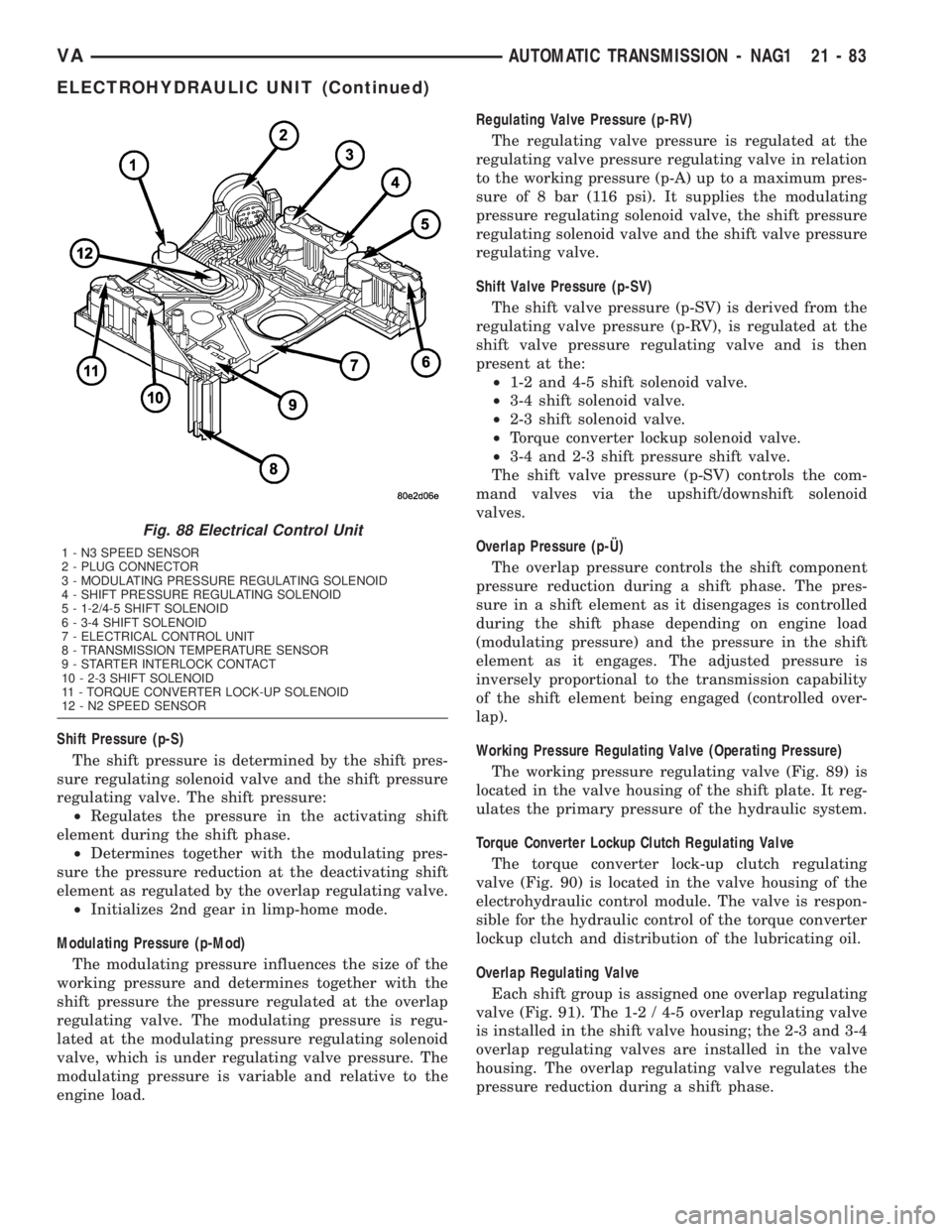
Shift Pressure (p-S)
The shift pressure is determined by the shift pres-
sure regulating solenoid valve and the shift pressure
regulating valve. The shift pressure:
²Regulates the pressure in the activating shift
element during the shift phase.
²Determines together with the modulating pres-
sure the pressure reduction at the deactivating shift
element as regulated by the overlap regulating valve.
²Initializes 2nd gear in limp-home mode.
Modulating Pressure (p-Mod)
The modulating pressure influences the size of the
working pressure and determines together with the
shift pressure the pressure regulated at the overlap
regulating valve. The modulating pressure is regu-
lated at the modulating pressure regulating solenoid
valve, which is under regulating valve pressure. The
modulating pressure is variable and relative to the
engine load.Regulating Valve Pressure (p-RV)
The regulating valve pressure is regulated at the
regulating valve pressure regulating valve in relation
to the working pressure (p-A) up to a maximum pres-
sure of 8 bar (116 psi). It supplies the modulating
pressure regulating solenoid valve, the shift pressure
regulating solenoid valve and the shift valve pressure
regulating valve.
Shift Valve Pressure (p-SV)
The shift valve pressure (p-SV) is derived from the
regulating valve pressure (p-RV), is regulated at the
shift valve pressure regulating valve and is then
present at the:
²1-2 and 4-5 shift solenoid valve.
²3-4 shift solenoid valve.
²2-3 shift solenoid valve.
²Torque converter lockup solenoid valve.
²3-4 and 2-3 shift pressure shift valve.
The shift valve pressure (p-SV) controls the com-
mand valves via the upshift/downshift solenoid
valves.
Overlap Pressure (p-š)
The overlap pressure controls the shift component
pressure reduction during a shift phase. The pres-
sure in a shift element as it disengages is controlled
during the shift phase depending on engine load
(modulating pressure) and the pressure in the shift
element as it engages. The adjusted pressure is
inversely proportional to the transmission capability
of the shift element being engaged (controlled over-
lap).
Working Pressure Regulating Valve (Operating Pressure)
The working pressure regulating valve (Fig. 89) is
located in the valve housing of the shift plate. It reg-
ulates the primary pressure of the hydraulic system.
Torque Converter Lockup Clutch Regulating Valve
The torque converter lock-up clutch regulating
valve (Fig. 90) is located in the valve housing of the
electrohydraulic control module. The valve is respon-
sible for the hydraulic control of the torque converter
lockup clutch and distribution of the lubricating oil.
Overlap Regulating Valve
Each shift group is assigned one overlap regulating
valve (Fig. 91). The 1-2 / 4-5 overlap regulating valve
is installed in the shift valve housing; the 2-3 and 3-4
overlap regulating valves are installed in the valve
housing. The overlap regulating valve regulates the
pressure reduction during a shift phase.
Fig. 88 Electrical Control Unit
1 - N3 SPEED SENSOR
2 - PLUG CONNECTOR
3 - MODULATING PRESSURE REGULATING SOLENOID
4 - SHIFT PRESSURE REGULATING SOLENOID
5 - 1-2/4-5 SHIFT SOLENOID
6 - 3-4 SHIFT SOLENOID
7 - ELECTRICAL CONTROL UNIT
8 - TRANSMISSION TEMPERATURE SENSOR
9 - STARTER INTERLOCK CONTACT
10 - 2-3 SHIFT SOLENOID
11 - TORQUE CONVERTER LOCK-UP SOLENOID
12 - N2 SPEED SENSOR
VAAUTOMATIC TRANSMISSION - NAG1 21 - 83
ELECTROHYDRAULIC UNIT (Continued)
Page 960 of 1232
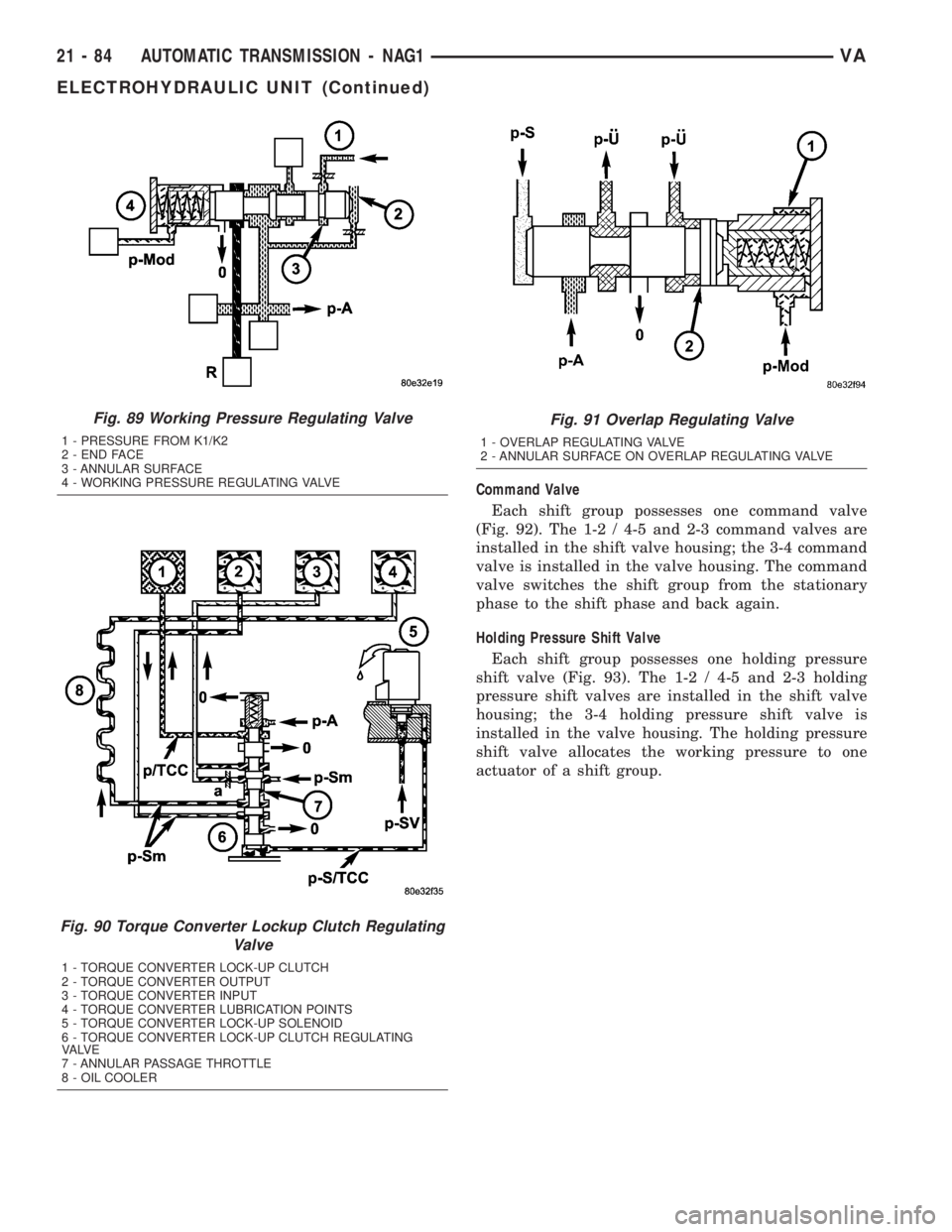
Command Valve
Each shift group possesses one command valve
(Fig. 92). The 1-2 / 4-5 and 2-3 command valves are
installed in the shift valve housing; the 3-4 command
valve is installed in the valve housing. The command
valve switches the shift group from the stationary
phase to the shift phase and back again.
Holding Pressure Shift Valve
Each shift group possesses one holding pressure
shift valve (Fig. 93). The 1-2 / 4-5 and 2-3 holding
pressure shift valves are installed in the shift valve
housing; the 3-4 holding pressure shift valve is
installed in the valve housing. The holding pressure
shift valve allocates the working pressure to one
actuator of a shift group.
Fig. 89 Working Pressure Regulating Valve
1 - PRESSURE FROM K1/K2
2 - END FACE
3 - ANNULAR SURFACE
4 - WORKING PRESSURE REGULATING VALVE
Fig. 90 Torque Converter Lockup Clutch Regulating
Valve
1 - TORQUE CONVERTER LOCK-UP CLUTCH
2 - TORQUE CONVERTER OUTPUT
3 - TORQUE CONVERTER INPUT
4 - TORQUE CONVERTER LUBRICATION POINTS
5 - TORQUE CONVERTER LOCK-UP SOLENOID
6 - TORQUE CONVERTER LOCK-UP CLUTCH REGULATING
VA LV E
7 - ANNULAR PASSAGE THROTTLE
8 - OIL COOLER
Fig. 91 Overlap Regulating Valve
1 - OVERLAP REGULATING VALVE
2 - ANNULAR SURFACE ON OVERLAP REGULATING VALVE
21 - 84 AUTOMATIC TRANSMISSION - NAG1VA
ELECTROHYDRAULIC UNIT (Continued)
Page 963 of 1232
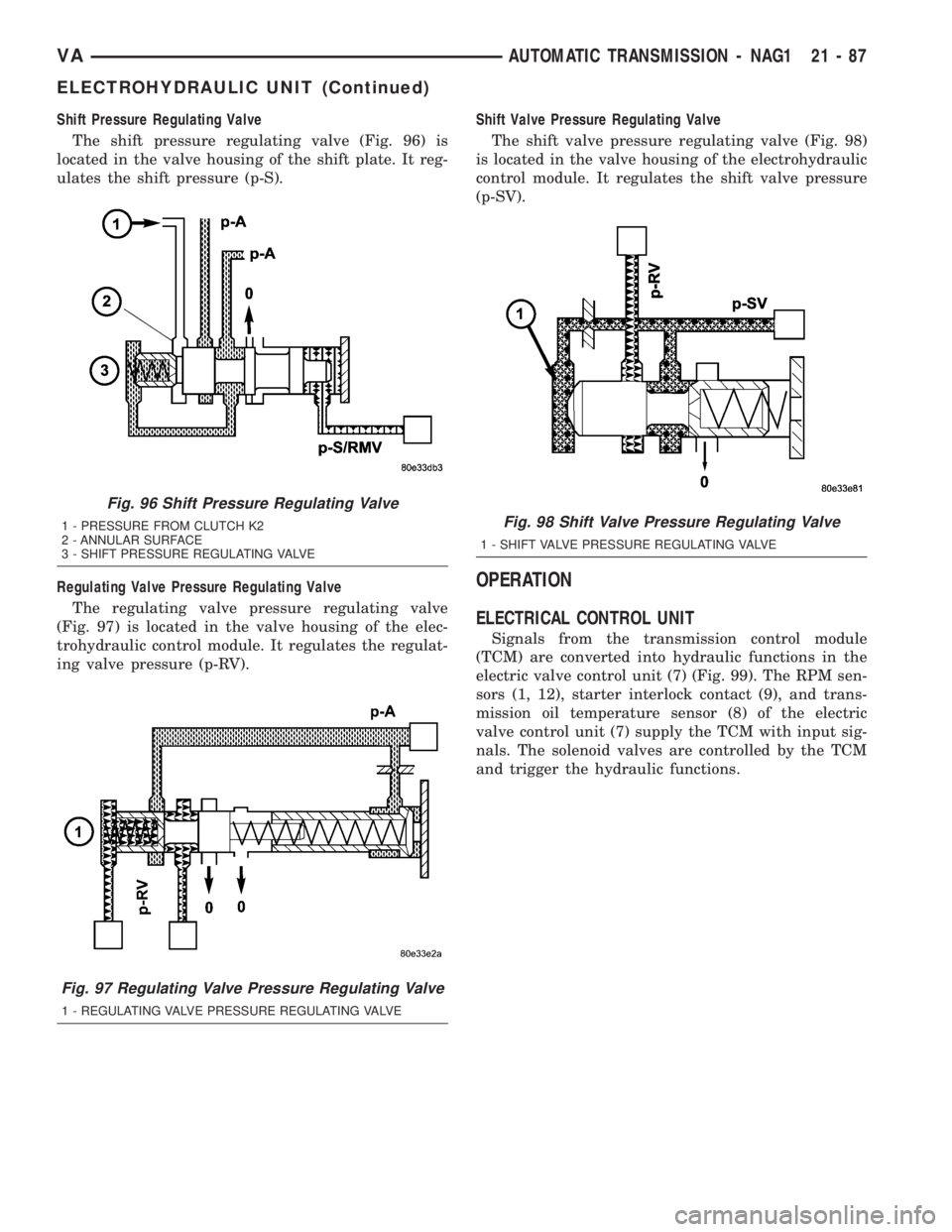
Shift Pressure Regulating Valve
The shift pressure regulating valve (Fig. 96) is
located in the valve housing of the shift plate. It reg-
ulates the shift pressure (p-S).
Regulating Valve Pressure Regulating Valve
The regulating valve pressure regulating valve
(Fig. 97) is located in the valve housing of the elec-
trohydraulic control module. It regulates the regulat-
ing valve pressure (p-RV).Shift Valve Pressure Regulating Valve
The shift valve pressure regulating valve (Fig. 98)
is located in the valve housing of the electrohydraulic
control module. It regulates the shift valve pressure
(p-SV).
OPERATION
ELECTRICAL CONTROL UNIT
Signals from the transmission control module
(TCM) are converted into hydraulic functions in the
electric valve control unit (7) (Fig. 99). The RPM sen-
sors (1, 12), starter interlock contact (9), and trans-
mission oil temperature sensor (8) of the electric
valve control unit (7) supply the TCM with input sig-
nals. The solenoid valves are controlled by the TCM
and trigger the hydraulic functions.
Fig. 96 Shift Pressure Regulating Valve
1 - PRESSURE FROM CLUTCH K2
2 - ANNULAR SURFACE
3 - SHIFT PRESSURE REGULATING VALVE
Fig. 97 Regulating Valve Pressure Regulating Valve
1 - REGULATING VALVE PRESSURE REGULATING VALVE
Fig. 98 Shift Valve Pressure Regulating Valve
1 - SHIFT VALVE PRESSURE REGULATING VALVE
VAAUTOMATIC TRANSMISSION - NAG1 21 - 87
ELECTROHYDRAULIC UNIT (Continued)
Page 964 of 1232
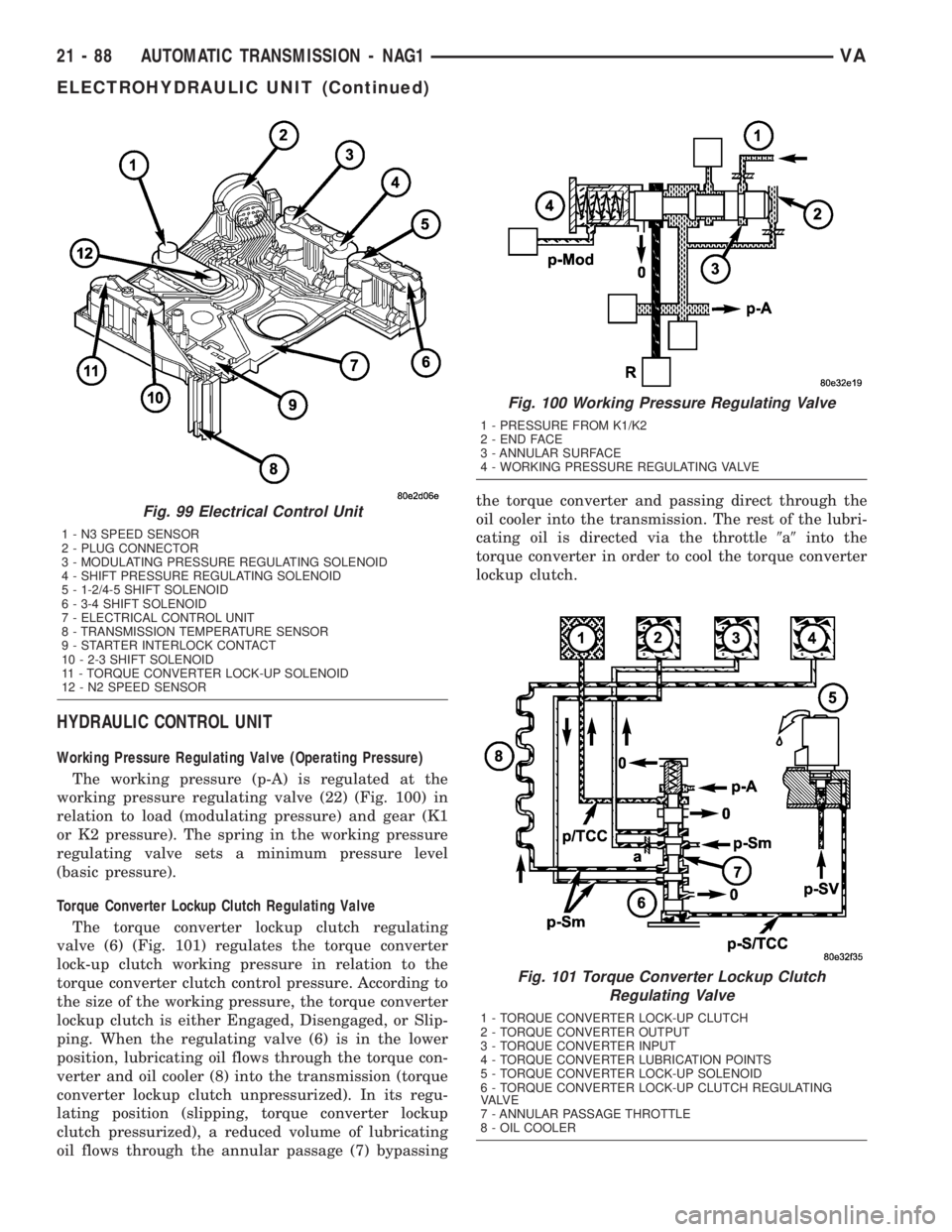
HYDRAULIC CONTROL UNIT
Working Pressure Regulating Valve (Operating Pressure)
The working pressure (p-A) is regulated at the
working pressure regulating valve (22) (Fig. 100) in
relation to load (modulating pressure) and gear (K1
or K2 pressure). The spring in the working pressure
regulating valve sets a minimum pressure level
(basic pressure).
Torque Converter Lockup Clutch Regulating Valve
The torque converter lockup clutch regulating
valve (6) (Fig. 101) regulates the torque converter
lock-up clutch working pressure in relation to the
torque converter clutch control pressure. According to
the size of the working pressure, the torque converter
lockup clutch is either Engaged, Disengaged, or Slip-
ping. When the regulating valve (6) is in the lower
position, lubricating oil flows through the torque con-
verter and oil cooler (8) into the transmission (torque
converter lockup clutch unpressurized). In its regu-
lating position (slipping, torque converter lockup
clutch pressurized), a reduced volume of lubricating
oil flows through the annular passage (7) bypassingthe torque converter and passing direct through the
oil cooler into the transmission. The rest of the lubri-
cating oil is directed via the throttle9a9into the
torque converter in order to cool the torque converter
lockup clutch.
Fig. 99 Electrical Control Unit
1 - N3 SPEED SENSOR
2 - PLUG CONNECTOR
3 - MODULATING PRESSURE REGULATING SOLENOID
4 - SHIFT PRESSURE REGULATING SOLENOID
5 - 1-2/4-5 SHIFT SOLENOID
6 - 3-4 SHIFT SOLENOID
7 - ELECTRICAL CONTROL UNIT
8 - TRANSMISSION TEMPERATURE SENSOR
9 - STARTER INTERLOCK CONTACT
10 - 2-3 SHIFT SOLENOID
11 - TORQUE CONVERTER LOCK-UP SOLENOID
12 - N2 SPEED SENSOR
Fig. 100 Working Pressure Regulating Valve
1 - PRESSURE FROM K1/K2
2 - END FACE
3 - ANNULAR SURFACE
4 - WORKING PRESSURE REGULATING VALVE
Fig. 101 Torque Converter Lockup Clutch
Regulating Valve
1 - TORQUE CONVERTER LOCK-UP CLUTCH
2 - TORQUE CONVERTER OUTPUT
3 - TORQUE CONVERTER INPUT
4 - TORQUE CONVERTER LUBRICATION POINTS
5 - TORQUE CONVERTER LOCK-UP SOLENOID
6 - TORQUE CONVERTER LOCK-UP CLUTCH REGULATING
VA LV E
7 - ANNULAR PASSAGE THROTTLE
8 - OIL COOLER
21 - 88 AUTOMATIC TRANSMISSION - NAG1VA
ELECTROHYDRAULIC UNIT (Continued)
Page 967 of 1232
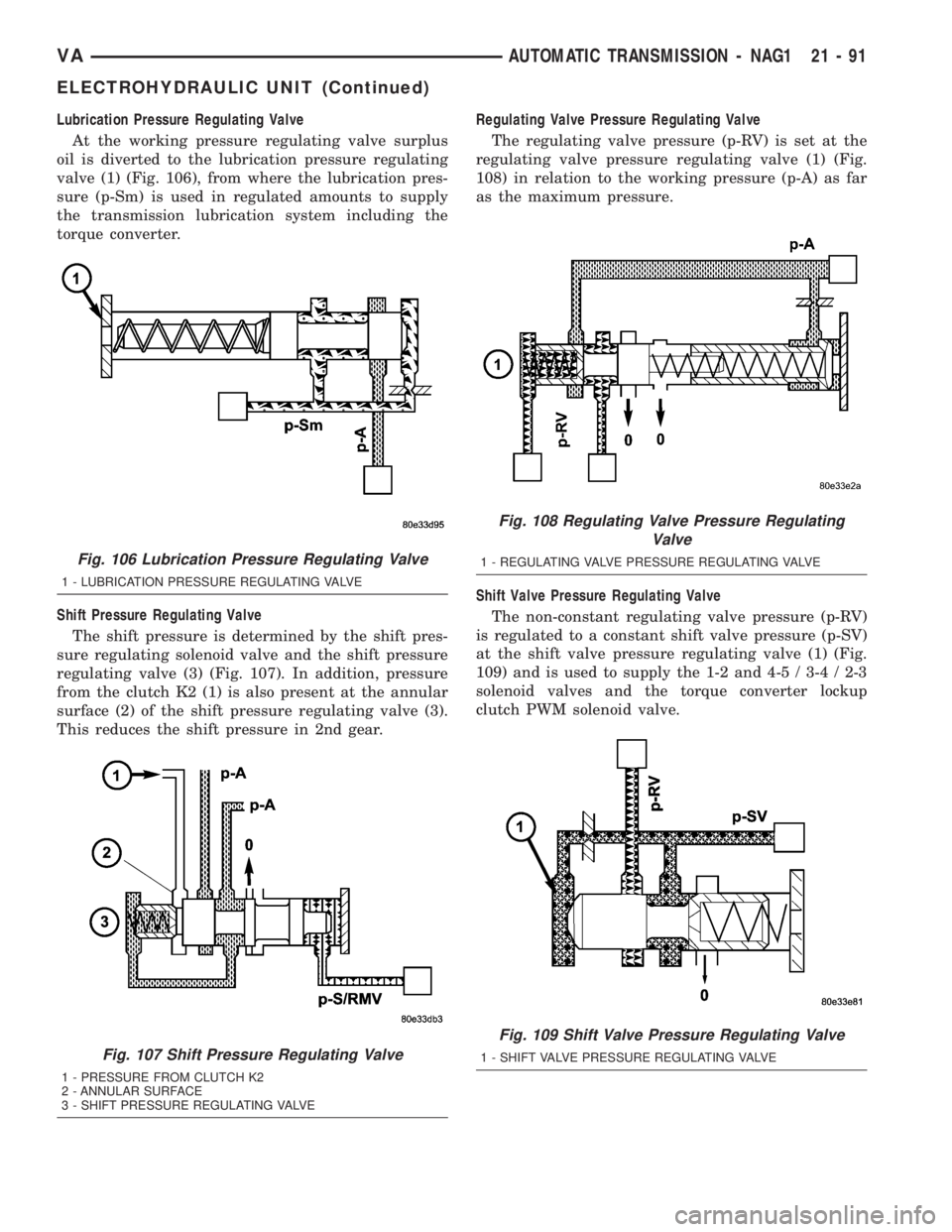
Lubrication Pressure Regulating Valve
At the working pressure regulating valve surplus
oil is diverted to the lubrication pressure regulating
valve (1) (Fig. 106), from where the lubrication pres-
sure (p-Sm) is used in regulated amounts to supply
the transmission lubrication system including the
torque converter.
Shift Pressure Regulating Valve
The shift pressure is determined by the shift pres-
sure regulating solenoid valve and the shift pressure
regulating valve (3) (Fig. 107). In addition, pressure
from the clutch K2 (1) is also present at the annular
surface (2) of the shift pressure regulating valve (3).
This reduces the shift pressure in 2nd gear.Regulating Valve Pressure Regulating Valve
The regulating valve pressure (p-RV) is set at the
regulating valve pressure regulating valve (1) (Fig.
108) in relation to the working pressure (p-A) as far
as the maximum pressure.
Shift Valve Pressure Regulating Valve
The non-constant regulating valve pressure (p-RV)
is regulated to a constant shift valve pressure (p-SV)
at the shift valve pressure regulating valve (1) (Fig.
109) and is used to supply the 1-2 and 4-5 / 3-4 / 2-3
solenoid valves and the torque converter lockup
clutch PWM solenoid valve.
Fig. 106 Lubrication Pressure Regulating Valve
1 - LUBRICATION PRESSURE REGULATING VALVE
Fig. 107 Shift Pressure Regulating Valve
1 - PRESSURE FROM CLUTCH K2
2 - ANNULAR SURFACE
3 - SHIFT PRESSURE REGULATING VALVE
Fig. 108 Regulating Valve Pressure Regulating
Valve
1 - REGULATING VALVE PRESSURE REGULATING VALVE
Fig. 109 Shift Valve Pressure Regulating Valve
1 - SHIFT VALVE PRESSURE REGULATING VALVE
VAAUTOMATIC TRANSMISSION - NAG1 21 - 91
ELECTROHYDRAULIC UNIT (Continued)
Page 969 of 1232

NOTE: Check O-rings on solenoid valves for dam-
age and replace if necessary.
(6) Bend away retaining lug on stiffening rib on
transmission oil temperature sensor.
(7) Remove electrohydraulic control module (12)
from the shift plate (13).
(8) Note the locations of the major shift valve
group components for assembly reference (Fig. 114).
NOTE: Pay great attention to cleanliness for all
work on the shift plate. Fluffy cloths must not be
used. Leather cloths are particularly good. After dis-
mantling, all parts must be washed and blown out
with compressed-air, noting that parts may be
blown away.
(9) Unbolt leaf spring (5) (Fig. 115).
(10) Unscrew Torx bolts (1) (Fig. 115).
(11) Remove valve housing (2) from valve body (4)
(Fig. 115).
Fig. 113 Electrical Unit Components
1 - SOLENOID CAP
2 - SOLENOID CAP
3 - BOLT - M6X32
4 - BOLT - M6X30
5 - LEAF SPRING
6 - MODULATING PRESSURE REGULATING SOLENOID VALVE
7 - SHIFT PRESSURE REGULATING SOLENOID
8 - 3-4 SHIFT SOLENOID
9 - TORQUE CONVERTER LOCK-UP SOLENOID
10 - 1-2/4-5 SHIFT SOLENOID
11 - 2-3 SHIFT SOLENOID
12 - ELECTRICHYDRAULIC CONTROL MODULE
13 - SHIFT PLATE
Fig. 114 Shift Valve Group Locations
A - OPERATING AND LUBRICATING PRESSURE REGULATING
VALVES AND 2-3 OVERLAP VALVE
B - 1-2/4-5 SHIFT GROUP AND SHIFT, SHIFT VALVE, AND
REGULATING VALVE PRESSURE REGULATING VALVES
C - 3-4 SHIFT GROUP
D - 2-3 SHIFT GROUP, TCC LOCK-UP AND B2 REGULATING
VA LV E S
Fig. 115 Shift Plate Components
1-BOLTS-29
2 - VALVE HOUSING
3 - SEALING PLATE
4 - VALVE BODY
5 - LEAF SPRING
VAAUTOMATIC TRANSMISSION - NAG1 21 - 93
ELECTROHYDRAULIC UNIT (Continued)
Page 975 of 1232
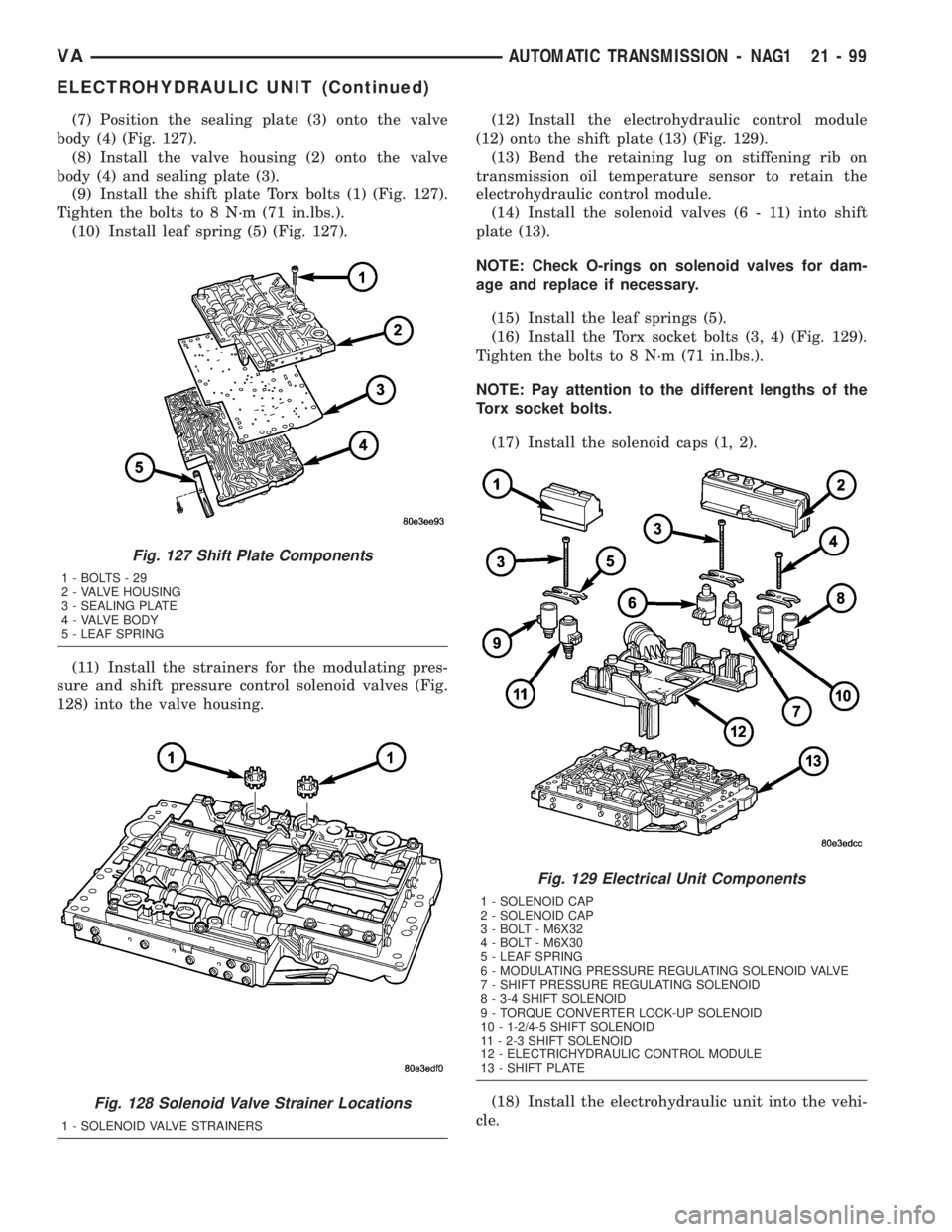
(7) Position the sealing plate (3) onto the valve
body (4) (Fig. 127).
(8) Install the valve housing (2) onto the valve
body (4) and sealing plate (3).
(9) Install the shift plate Torx bolts (1) (Fig. 127).
Tighten the bolts to 8 N´m (71 in.lbs.).
(10) Install leaf spring (5) (Fig. 127).
(11) Install the strainers for the modulating pres-
sure and shift pressure control solenoid valves (Fig.
128) into the valve housing.(12) Install the electrohydraulic control module
(12) onto the shift plate (13) (Fig. 129).
(13) Bend the retaining lug on stiffening rib on
transmission oil temperature sensor to retain the
electrohydraulic control module.
(14) Install the solenoid valves (6 - 11) into shift
plate (13).
NOTE: Check O-rings on solenoid valves for dam-
age and replace if necessary.
(15) Install the leaf springs (5).
(16) Install the Torx socket bolts (3, 4) (Fig. 129).
Tighten the bolts to 8 N´m (71 in.lbs.).
NOTE: Pay attention to the different lengths of the
Torx socket bolts.
(17) Install the solenoid caps (1, 2).
(18) Install the electrohydraulic unit into the vehi-
cle.
Fig. 127 Shift Plate Components
1-BOLTS-29
2 - VALVE HOUSING
3 - SEALING PLATE
4 - VALVE BODY
5 - LEAF SPRING
Fig. 128 Solenoid Valve Strainer Locations
1 - SOLENOID VALVE STRAINERS
Fig. 129 Electrical Unit Components
1 - SOLENOID CAP
2 - SOLENOID CAP
3 - BOLT - M6X32
4 - BOLT - M6X30
5 - LEAF SPRING
6 - MODULATING PRESSURE REGULATING SOLENOID VALVE
7 - SHIFT PRESSURE REGULATING SOLENOID
8 - 3-4 SHIFT SOLENOID
9 - TORQUE CONVERTER LOCK-UP SOLENOID
10 - 1-2/4-5 SHIFT SOLENOID
11 - 2-3 SHIFT SOLENOID
12 - ELECTRICHYDRAULIC CONTROL MODULE
13 - SHIFT PLATE
VAAUTOMATIC TRANSMISSION - NAG1 21 - 99
ELECTROHYDRAULIC UNIT (Continued)
Page 978 of 1232
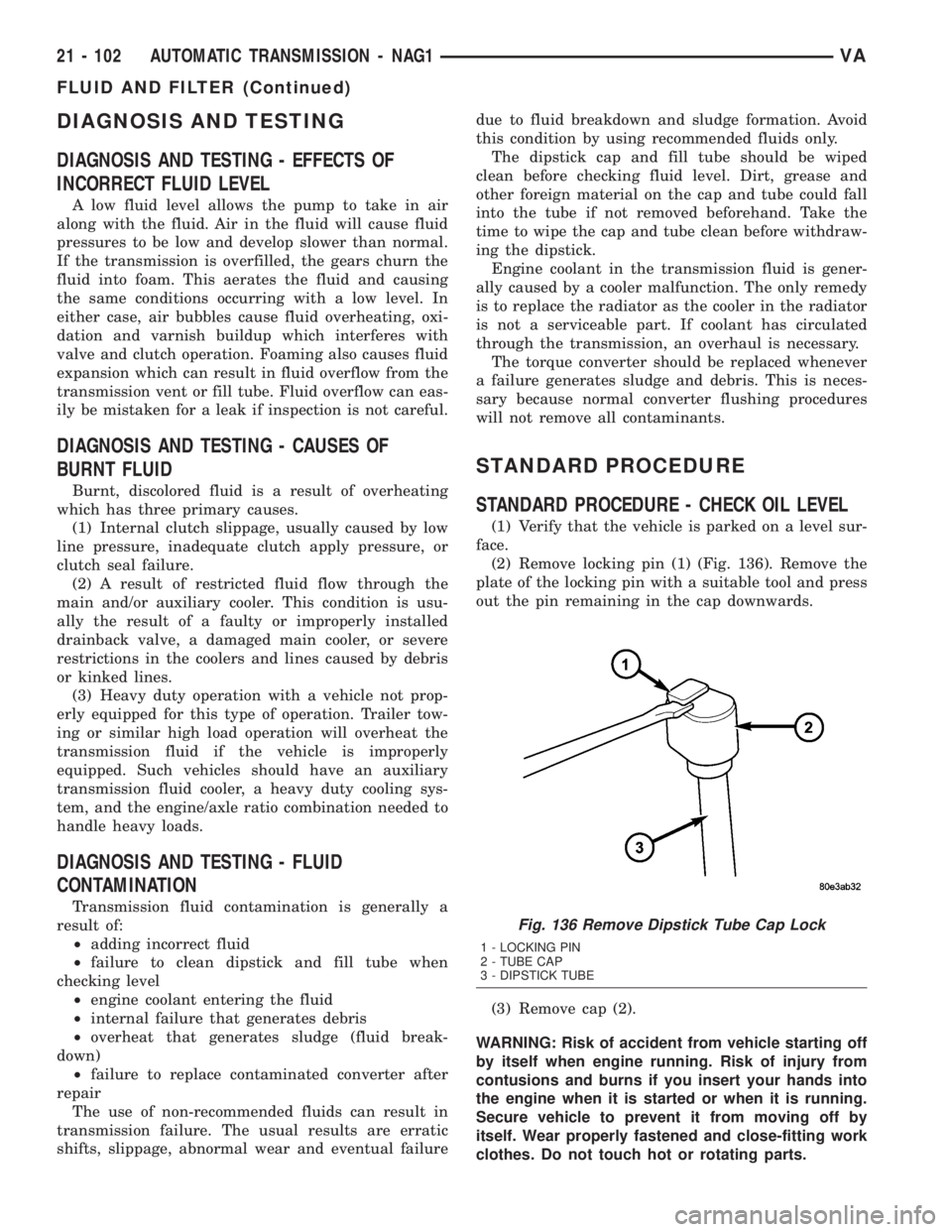
DIAGNOSIS AND TESTING
DIAGNOSIS AND TESTING - EFFECTS OF
INCORRECT FLUID LEVEL
A low fluid level allows the pump to take in air
along with the fluid. Air in the fluid will cause fluid
pressures to be low and develop slower than normal.
If the transmission is overfilled, the gears churn the
fluid into foam. This aerates the fluid and causing
the same conditions occurring with a low level. In
either case, air bubbles cause fluid overheating, oxi-
dation and varnish buildup which interferes with
valve and clutch operation. Foaming also causes fluid
expansion which can result in fluid overflow from the
transmission vent or fill tube. Fluid overflow can eas-
ily be mistaken for a leak if inspection is not careful.
DIAGNOSIS AND TESTING - CAUSES OF
BURNT FLUID
Burnt, discolored fluid is a result of overheating
which has three primary causes.
(1) Internal clutch slippage, usually caused by low
line pressure, inadequate clutch apply pressure, or
clutch seal failure.
(2) A result of restricted fluid flow through the
main and/or auxiliary cooler. This condition is usu-
ally the result of a faulty or improperly installed
drainback valve, a damaged main cooler, or severe
restrictions in the coolers and lines caused by debris
or kinked lines.
(3) Heavy duty operation with a vehicle not prop-
erly equipped for this type of operation. Trailer tow-
ing or similar high load operation will overheat the
transmission fluid if the vehicle is improperly
equipped. Such vehicles should have an auxiliary
transmission fluid cooler, a heavy duty cooling sys-
tem, and the engine/axle ratio combination needed to
handle heavy loads.
DIAGNOSIS AND TESTING - FLUID
CONTAMINATION
Transmission fluid contamination is generally a
result of:
²adding incorrect fluid
²failure to clean dipstick and fill tube when
checking level
²engine coolant entering the fluid
²internal failure that generates debris
²overheat that generates sludge (fluid break-
down)
²failure to replace contaminated converter after
repair
The use of non-recommended fluids can result in
transmission failure. The usual results are erratic
shifts, slippage, abnormal wear and eventual failuredue to fluid breakdown and sludge formation. Avoid
this condition by using recommended fluids only.
The dipstick cap and fill tube should be wiped
clean before checking fluid level. Dirt, grease and
other foreign material on the cap and tube could fall
into the tube if not removed beforehand. Take the
time to wipe the cap and tube clean before withdraw-
ing the dipstick.
Engine coolant in the transmission fluid is gener-
ally caused by a cooler malfunction. The only remedy
is to replace the radiator as the cooler in the radiator
is not a serviceable part. If coolant has circulated
through the transmission, an overhaul is necessary.
The torque converter should be replaced whenever
a failure generates sludge and debris. This is neces-
sary because normal converter flushing procedures
will not remove all contaminants.
STANDARD PROCEDURE
STANDARD PROCEDURE - CHECK OIL LEVEL
(1) Verify that the vehicle is parked on a level sur-
face.
(2) Remove locking pin (1) (Fig. 136). Remove the
plate of the locking pin with a suitable tool and press
out the pin remaining in the cap downwards.
(3) Remove cap (2).
WARNING: Risk of accident from vehicle starting off
by itself when engine running. Risk of injury from
contusions and burns if you insert your hands into
the engine when it is started or when it is running.
Secure vehicle to prevent it from moving off by
itself. Wear properly fastened and close-fitting work
clothes. Do not touch hot or rotating parts.
Fig. 136 Remove Dipstick Tube Cap Lock
1 - LOCKING PIN
2 - TUBE CAP
3 - DIPSTICK TUBE
21 - 102 AUTOMATIC TRANSMISSION - NAG1VA
FLUID AND FILTER (Continued)